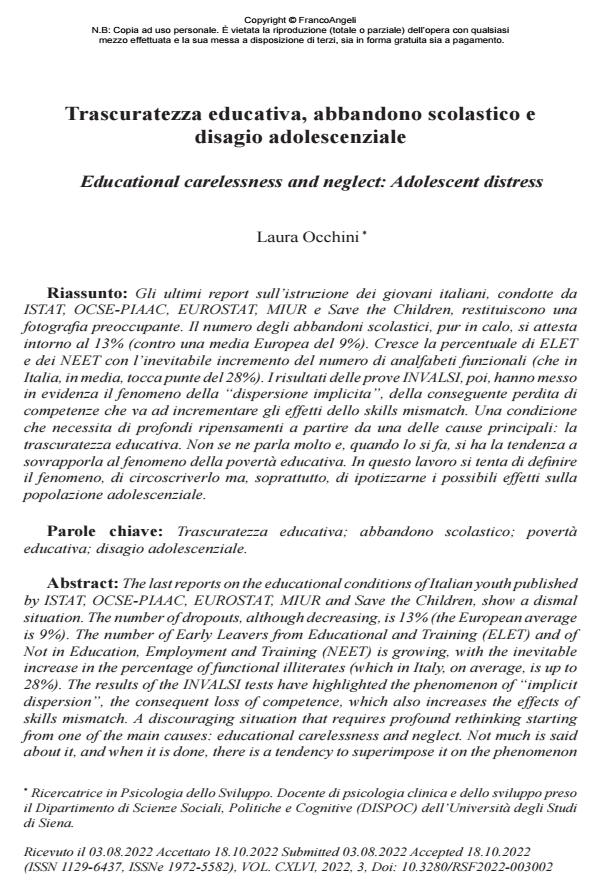Trascuratezza educativa, abbandono scolastico e disagio adolescenziale
Titolo Rivista RIVISTA SPERIMENTALE DI FRENIATRIA
Autori/Curatori Laura Occhini
Anno di pubblicazione 2022 Fascicolo 2022/3
Lingua Italiano Numero pagine 21 P. 9-29 Dimensione file 217 KB
DOI 10.3280/RSF2022-003002
Il DOI è il codice a barre della proprietà intellettuale: per saperne di più
clicca qui
Qui sotto puoi vedere in anteprima la prima pagina di questo articolo.
Se questo articolo ti interessa, lo puoi acquistare (e scaricare in formato pdf) seguendo le facili indicazioni per acquistare il download credit. Acquista Download Credits per scaricare questo Articolo in formato PDF

FrancoAngeli è membro della Publishers International Linking Association, Inc (PILA)associazione indipendente e non profit per facilitare (attraverso i servizi tecnologici implementati da CrossRef.org) l’accesso degli studiosi ai contenuti digitali nelle pubblicazioni professionali e scientifiche
Gli ultimi report sull’istruzione dei giovani italiani, condotte da ISTAT, OCSE-PIAAC, EUROSTAT, MIUR e Save the Children, restituiscono una fotografia preoccupante. Il numero degli abbandoni scolastici, pur in calo, si attesta intorno al 13% (contro una media Europea del 9%). Cresce la percentuale di ELET e dei NEET con l’inevitabile incremento del numero di analfabeti funzionali (che in Italia, in media, tocca punte del 28%). I risultati delle prove INVALSI, poi, hanno messo in evidenza il fenomeno della "dispersione implicita", della conseguente perdita di competenze che va ad incrementare gli effetti dello skills mismatch. Una condizione che necessita di profondi ripensamenti a partire da una delle cause principali: la trascuratezza educativa. Non se ne parla molto e, quando lo si fa, si ha la tendenza a sovrapporla al fenomeno della povertà educativa. In questo lavoro si tenta di definire il fenomeno, di circoscriverlo ma, soprattutto, di ipotizzarne i possibili effetti sulla popolazione adolescenziale.
Parole chiave:Trascuratezza educativa; abbandono scolastico; povertà educativa; disagio adolescenziale.
- La valutazione di fronte alle sfide della transizione digitale: una riflessione a partire dall’esperienza di mappatura delle politiche di contrasto alla povertà educativa minorile Eleonora Rossero, Gaia Testore, in Community Notebook. People, Education and Welfare in the Society 5.0 4/2025 pp.205
DOI: 10.61007/QdC.2025.3.322
Laura Occhini, Trascuratezza educativa, abbandono scolastico e disagio adolescenziale in "RIVISTA SPERIMENTALE DI FRENIATRIA" 3/2022, pp 9-29, DOI: 10.3280/RSF2022-003002